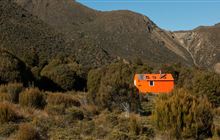More water on tap at six DOC huts on Te Araroa
Introduction
New water tanks will help keep water on tap for high numbers of Te Araroa trail walkers at six huts in the top of the South Island where water has often run out in summer.Date: 18 December 2023
The Te Araroa Trust has provided 2000-litre rainwater tanks at DOC huts, Starveall, Slaty, Tarn, Hunters and Red Hills in the Richmond Ranges and at Blue Lake Hut in Nelson Lakes National Park. At each hut, the additional tank supplements an existing 2000-litre tank.
DOC Nelson Lakes Operations Manager John Wotherspoon says being part of Te Araroa has considerably increased usage of the backcountry Richmond Ranges huts, from scores to thousands of people a year staying overnight, and in dry summer weather, tank water often runs out.
“Some Richmond Ranges huts have rivers or streams nearby where people can get water, but tank water running out has particularly been a problem at high-altitude huts where there is no nearby water source.
“Blue Lake Hut is busy in summer both with Te Araroa walkers and others making the trip to see the stunning Rotomairewhenua/Blue Lake, which is reported to have the clearest freshwater in the world. Rotomairewhenua is tapu/sacred to mana whenua iwi, particularly to Ngāti Apa ki te Rā Tō. People are asked not to touch the water in these lakes to uphold their mauri/life force and pureness.
“Extra tank water will reduce the possibility of people filling their water bottles from the lake.
“We’re grateful to Te Araroa Trust for stepping in to provide the six additional water tanks so people staying at these huts over summer have more likelihood of water coming out when they turn on the taps.”
Around 4000 people a year make the 3000-kilometre Te Araroa journey from Cape Reinga in the north to Bluff in the south.
Te Araroa Trust’s executive director Matt Claridge says the new tanks are a valuable addition to the trail.
“Thanks to funding from the New Zealand Community Trust, our walkers will have access to fresh water onsite and when you’re walking the length of the country this is a huge benefit.
Mr Claridge says thanks must also go to Te Araroa Te Tau Ihu Trust (Nelson/Marlborough) for helping facilitate the installation of the tanks.
The Richmond Ranges is one of the most challenging Te Araroa sections and DOC advises people walking the route to be well prepared for its rugged terrain and the possibility of flooded rivers, freezing temperatures and snow.
“Advanced tramping skills, including river crossing skills, along with alpine tramping and navigational experience are needed for walking the Richmond Ranges route,” says John Wotherspoon.
“We strongly recommend people don’t pack light, aiming to walk the route quickly, as they can be caught out if there are delays due to bad weather or flooded rivers. People should wear sturdy footwear and carry extra food, plenty of warm clothing and a tent or other emergency shelter. They should also have a distress beacon to get help if needed.
“Many river crossings are unbridged. People should not attempt to cross flooded rivers if unsure it’s safe and there are no clear points to enter and exit the river – turn back or wait for the water level to drop.”
People planning to walk the Richmond Ranges are advised to read the Richmond Ranges Te Araroa route information on the DOC website to ensure they are well prepared and that the trip is right for them.
DOC will be surveying southbound Te Araroa walkers at Blue Lake Hut in Nelson Lakes National Park over much of the summer to gauge numbers using DOC huts, campsites and tracks in the top of the South Island. Walkers will also be asked to rate their experience of these facilities.
Contact
For media enquiries contact:
Email: media@doc.govt.nz

